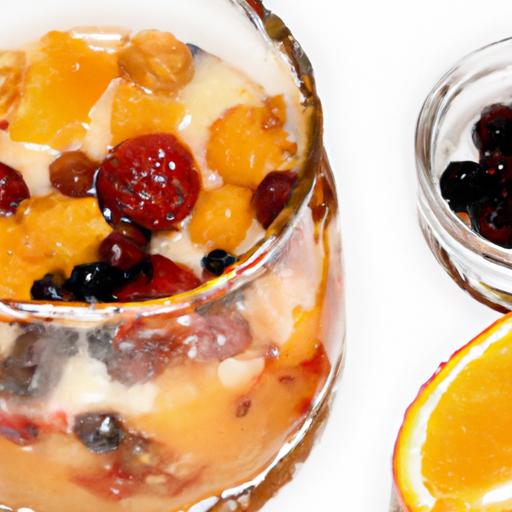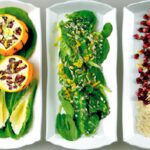In the vibrant world of culinary delights, fruit sauces add a splash of color, flavor, and flair to both desserts and savory dishes alike. Yet, when it comes to fruit-based accompaniments, the terms “coulis” and “compote” often swirl together in a confusing dance. Are they simply two names for the same thing, or do these luscious preparations each hold their own unique story and role on the plate? Join us as we unravel the saucy secrets of coulis versus compote-exploring their origins, textures, and uses-to help you master these fruity essentials and elevate your cooking to delicious new heights.
Understanding Texture and Consistency Differences in Coulis and Compote
Coulis vs Compote: Unraveling Saucy Fruit Secrets begins by exploring the subtle yet impactful differences in texture and consistency that define these two delightful fruit sauces. A coulis is a smooth, velvety puree-strained meticulously to remove seeds and pulp-resulting in a refined sauce that gently cloaks desserts and savory plates alike. In contrast, a compote celebrates the rustic charm of gently simmered whole or chunked fruit, often retaining its shape and yielding a cozy, chunky texture that bursts with natural sweetness.
The beauty of these fruit preparations lies not only in their texture but also in how their appearance invites anticipation. A glistening, crimson raspberry coulis swirling over a cheesecake provides a sleek sophistication, while a thick, jewel-toned compote serenades your spoon with juicy, plump fruit pieces, inviting more leisurely savoring.
Exploring Flavor Profiles and Culinary Uses for Saucy Fruits
Coulis unlocks the pure essence of fruit-think tangy, bright, and concentrated flavors-from berries, stone fruits, or tropical varieties. It’s often enhanced subtly with lemon zest or a hint of vanilla to heighten its vibrancy without overpowering the delicate aroma. This makes coulis an incredibly versatile companion for desserts like panna cotta, ice cream, or flourless chocolate cake, lending a refreshing counterpoint that brightens every bite.
On the other hand, compote encourages more complexity with gentle cooking, often infused with warm spices like cinnamon, star anise, or cardamom, enhancing the natural sweetness and aroma as the fruit softens. Apples, pears, figs, or cherries become the stars here. Savory dishes also enjoy compote’s presence, where it complements roasted meats, game, and even cheese boards, offering a balanced sweet and savory interplay.
Step by Step Guide to Perfecting Your Coulis and Compote at Home
Prep and Cook Time
- Coulis: Prep: 10 minutes | Cook: 5 minutes
- Compote: Prep: 10 minutes | Cook: 25 minutes
Yield
- Approximately 1 cup (240 ml) of coulis or compote each, depending on fruit and reduction time
Difficulty Level
- Easy-ideal for home cooks eager to elevate dishes effortlessly
Ingredients
- For Berry Coulis:
- 2 cups fresh or frozen mixed berries (raspberries, strawberries, blueberries)
- ½ cup granulated sugar
- 2 tablespoons freshly squeezed lemon juice
- 2 tablespoons water (if needed)
- For Apple Spice Compote:
- 3 medium apples, peeled, cored, and chopped
- ¼ cup brown sugar
- ½ teaspoon ground cinnamon
- ¼ teaspoon ground nutmeg
- 1 teaspoon vanilla extract
- ½ cup water or apple cider
Instructions
- Make the Berry Coulis: In a medium saucepan, combine the berries, sugar, and lemon juice. Cook over medium heat, stirring occasionally, until the fruit breaks down and sugar dissolves, about 5 minutes.
- Remove from heat and blend using an immersion blender or regular blender until smooth. Strain through a fine mesh sieve to remove seeds, pressing gently with a spatula.
- If coulis is too thick, stir in water-1 tablespoon at a time-until desired consistency is reached. Chill before serving for a refreshing finish.
- Prepare the Apple Spice Compote: Place chopped apples, brown sugar, cinnamon, nutmeg, vanilla, and water or cider in a saucepan over medium heat.
- Simmer gently for 20-25 minutes, stirring occasionally, until the fruit softens but retains shape and the liquid thickens to a syrupy glaze.
- Let cool slightly or serve warm depending on your preference; compote thickens further while cooling.
Chef’s Notes and Tips for Success
- For a tangier coulis, swap half the sugar for honey or agave syrup.
- Add fresh herbs like basil or mint to the coulis during cooking for unique flavor contrasts.
- Compote freezes beautifully-store in airtight containers for up to 3 months.
- Adjust spice level in compote to taste, experimenting with cloves or ginger for seasonal variations.
- If your coulis is too watery after straining, simmer over low heat 1-2 minutes more to reduce.
Serving Suggestions
Present berry coulis drizzled artistically across plates or swirled atop creamy desserts for a vibrant pop of color and fresh fruit brightness. Garnish with a sprig of mint or edible flowers for extra elegance. Apple compote shines spooned warm alongside roasted pork, layered on pancakes or waffles for breakfast, or dolloped over a plump cheese-filled pastry. Consider toasting nuts like walnuts or pecans to sprinkle over compote for delightful texture contrast.
| Nutritional Information (per ¼ cup) | Coulis | Compote |
|---|---|---|
| Calories | 60 | 90 |
| Protein | 0.5g | 0.3g |
| Carbohydrates | 15g | 23g |
| Fat | 0g | 0g |
Discover more enriching ways to transform your fruit sauces in our Fruit Sauces 101 guide. For the science behind fruit purees and how to master strain techniques, check out this expert tutorial from Cook’s Illustrated.

Q&A
Q&A: Coulis vs Compote – Unraveling Saucy Fruit Secrets
Q: What exactly is a coulis?
A: Think of a coulis as the sleek superhero of fruit sauces. It’s a smooth, vibrant puree made by blending fresh or cooked fruits (or even vegetables) and then straining out all the seeds and pulp. The result? A velvety, intensely flavored sauce that’s often drizzled artistically over desserts or savory dishes to add a punch of fresh flavor and color.
Q: How does compote differ from coulis?
A: While coulis is silky and smooth, compote embraces its rustic charm with chunky, stewed fruits swimming in a syrupy bath. Imagine juicy berries, apples, or stone fruits softened just enough to release their sweetness but still holding onto their shape-a cozy, spoonable fruit melody perfect for topping pancakes, yogurt, or ice cream.
Q: Are their cooking methods very different?
A: Yes! Coulis is typically made by gently cooking fruit or sometimes using raw fruit blended and strained to preserve freshness and brightness. Compote, on the other hand, is gently simmered for longer periods, coaxing the fruit into tender, syrup-laden bliss.
Q: Can they be used interchangeably in recipes?
A: Not quite. Because coulis is light, smooth, and vibrant, it’s ideal for elegant plating and subtle flavor accents. Compote’s chunky texture and syrupy sweetness bring warmth and heartiness, lending themselves to rustic breakfasts or decadent dessert toppings. Swapping one for the other shifts the texture and intensity dramatically.
Q: Is one healthier than the other?
A: Both are fruit-based, but coulis often acts as a purer, less sugary sauce since it’s strained and sometimes raw or lightly cooked. Compote usually involves added sugar and longer cooking, increasing calories and reducing vitamin content slightly. Still, both are delightful ways to enjoy fruit!
Q: Can you make them out of any fruit?
A: Absolutely! Strawberries, raspberries, mangoes, peaches-for coulis, juicy and flavorful fruits are best. For compote, heartier fruits like apples, pears, and plums shine alongside berries. Each fruit brings its own personality to these luscious sauces.
Q: What are the best dishes to showcase coulis or compote?
A: Coulis loves the spotlight on delicate desserts like panna cotta, cheesecake, or even drizzled over savory dishes like duck breast or grilled fish. Compote is the breakfast hero-perfect on oatmeal, pancakes, or swirled into yogurt. It also adds a soul-soothing touch to spiced cakes and tarts.
Q: Any tips for homemade coulis or compote?
A: For coulis, don’t skip the straining-it makes all the difference in silky smoothness! Keep it fresh and tangy with a squeeze of lemon juice. For compote, simmer low and slow to unlock natural sweetness without turning mushy. Spice it up with cinnamon, vanilla, or a splash of liqueur for extra flair.
Q: In summary, why explore both?
A: Because coulis and compote are two sides of the same delicious fruit coin-each telling a different story through texture and intensity. Discovering their secrets unlocks a world where fruit sauces can dress up every meal, from the elegant to the everyday. Embrace the saucy side of fruit and let your palate dance!
The Conclusion
As we’ve unraveled the saucy secrets of coulis and compote, it’s clear that both bring their own unique flair to the world of fruit. Whether you’re drizzling a silky coulis to elevate a dessert or spooning a hearty compote for a comforting touch, understanding their differences unlocks a new dimension of culinary creativity. So next time you reach for a fruity accompaniment, remember: it’s not just about sweetness-it’s about texture, technique, and the art of flavoring your dishes with a splash of savvy sauce. Happy saucing!


